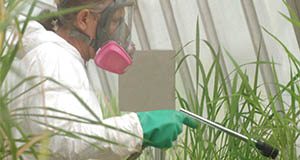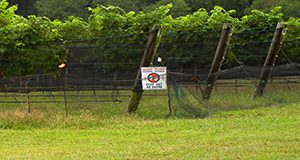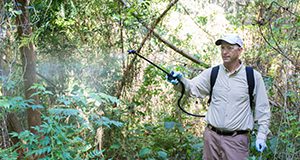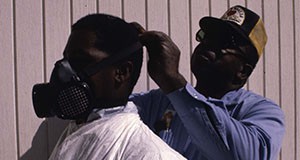The EPA’s Worker Protection Standard for Agricultural Pesticides (WPS) covers pesticides used in the outdoor and enclosed-space production of plants on farms, forests, and nurseries, as well as greenhouses. The WPS requires agricultural employers to take steps to reduce pesticide-related risks when agricultural workers and pesticide handlers are exposed to these pesticides. The EPA has made several changes to the WPS since it was fully implemented in 1995, and this new 3-page document addresses maintaining records of worker and handler training under the revised WPS, including a sample employee-training verification. Written by Frederick M. Fishel and published by the UF/IFAS Pesticide Information Office.
https://edis.ifas.ufl.edu/pi283
Tag: worker protection standard
Pesticide Recordkeeping Form for Florida Applicators
This new 5-page document provides a form containing the required elements to include on a record of pesticide application for meeting the restricted use pesticide and Worker Protection Standard (WPS) requirements. An example application record and an explanation of the required elements is provided. This is not a required form because there are other methods to keep records if they contain the required information. Handwritten notes, electronic records, and other recordkeeping software systems are also acceptable. Written by Frederick M. Fishel and published by the UF/IFAS Agronomy Department.
http://edis.ifas.ufl.edu/pi280
Worker Protection Standard: Requirements for Commercial Pesticide Handler Employers
In 1992, the US Environmental Protection Agency issued a comprehensive regulation called the Worker Protection Standard for Agricultural Pesticides (WPS). The EPA has made several changes to the WPS since it was fully implemented in 1995. This 5-page document will address the WPS protections commercial pesticide handler employers must provide to their handlers. Written by Frederick M. Fishel and published by the UF/IFAS Agronomy Department, January 2018.
http://edis.ifas.ufl.edu/pi275
Worker Protection Standard: Requirements for Agricultural Employers of Workers and Handlers
Safety is a high concern for agricultural employers whose workers deal with hazardous materials, such as pesticides. In 1992, the US Environmental Protection Agency (EPA) issued the Worker Protection Standard for Agricultural Pesticides (WPS), a regulation that requires agricultural employers to take steps to reduce pesticide-related risks for their workers and handlers. This five-page document describes the responsibilities of employers who must adhere to the WPS. Written by Frederick M. Fishel and published by the UF/IFAS Agronomy Department, January 2018.
http://edis.ifas.ufl.edu/ag417
Worker Protection Standard: Additional Requirements for Agricultural Employers of Workers
The Worker Protection Standard (WPS) Act for Agricultural Pesticides was established by the US Environmental Protection Agency in 1992 and has undergone several revisions since. Recent revised provisions became effective in January 2017. This document will address the additional requirements for agricultural employers of workers under the revised WPS. Written by Frederick M. Fishel and published by the UF/IFAS Agronomy Department, December 2017.
http://edis.ifas.ufl.edu/pi273
Worker Protection Standard: Determining Your WPS Responsibilities
In 1992, the US Environmental Protection Agency (EPA) issued a comprehensive regulation called the Worker Protection Standard for Agricultural Pesticides (WPS). The EPA has made several changes to the WPS since it was fully implemented in 1995. This five-page document will address determining responsibilities under the revised WPS. Written by Frederick M. Fishel and published by UF’s Agronomy Department, September 2017.
http://edis.ifas.ufl.edu/ag418
Quick Reference Guide to the Worker Protection Standard (WPS) as Revised in 2015
The Worker Protection Standard (WPS) is a regulation originally issued by the US Environmental Protection Agency (EPA) in 1992 and most recently revised in 2015. This eight-page reference guide gives an overview of the 2015 revisions. Written by Frederick M. Fishel, and published by the Agronomy Department.
http://edis.ifas.ufl.edu/pi270
Worker Protection Standard: Training Workers and Handlers under the 2016 Revision Requirements
In 1992, the US Environmental Protection Agency (EPA) issued a comprehensive regulation called the Worker Protection Standard for Agricultural Pesticides (WPS). The EPA has made several changes to the WPS since it was fully implemented in 1995. On November 2, 2015, the EPA revised the WPS, making significant changes to the rule’s requirements. Most of the revised provisions will become effective January 2, 2017; there are four provisions that are delayed until January 2, 2018. This five-page fact sheet answers questions regarding changes made to the rules about how to train Workers and Handlers. Written by Frederick M. Fishel and published by the Agronomy Department.
http://edis.ifas.ufl.edu/pi268
Worker Protection Standard: Certified Crop Advisor Exemption
In 1992, the US Environmental Protection Agency (EPA) issued a comprehensive regulation called the Worker Protection Standard for Agricultural Pesticides (WPS). The EPA has made several changes to the WPS since it was fully implemented in 1995. On November 2, 2015, the EPA made significant changes to the rule’s requirements. Most of the revised provisions will become effective January 2, 2017 and there are four provisions that are delayed until January 2, 2018. This five-page fact sheet answers questions regarding changes made to the exemptions for Certified Crop Advisors. Written by Frederick M. Fishel and Tatiana Sanchez and published by the Agronomy Department.
http://edis.ifas.ufl.edu/pi265
Worker Protection Standard: Notification and Hazard Communication
In 1992, the US Environmental Protection Agency (EPA) issued a comprehensive regulation called the Worker Protection Standard for Agricultural Pesticides (WPS). The EPA has made several changes to the WPS since it was fully implemented in 1995. On November 2, 2015, the EPA made significant changes to the rule’s requirements. Most of the revised provisions will become effective January 2, 2017 and there are four provisions that are delayed until January 2, 2018. This five-page fact sheet answers questions regarding changes made to the rules about notification and hazard communication. Written by Frederick M. Fishel and Tatiana Sanchez, and published by the Agronomy Department.
http://edis.ifas.ufl.edu/pi266
Worker Protection Standard: Information at a Central Location
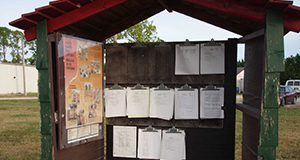
This three-page FAQ fact sheet answers questions about posting information at a central location per the regulations of the Worker Protection Standard (WPS).
Written by Frederick M. Fishel and Tatiana Sanchez and published by the Agronomy Department.
http://edis.ifas.ufl.edu/pi149
Worker Protection Standard: Owner and Immediate Family Exemption
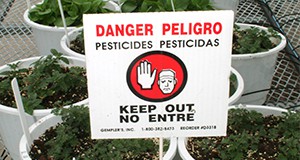
This three-page FAQ fact sheet answers questions about the exemptions for owners and their immediate families in the Worker Protection Standard (WPS).
Written by Frederick M. Fishel and Tatiana Sanchez and published by the Agronomy Department.
http://edis.ifas.ufl.edu/pi264
Worker Protection Standard: Personal Protective Equipment (PPE) 2016
In 1992, the US Environmental Protection Agency (EPA) issued a comprehensive regulation called the Worker Protection Standard for Agricultural Pesticides (WPS). The EPA has made several changes to the WPS since it was fully implemented in 1995. On November 2, 2015, the EPA made significant changes to the rule’s requirements. Most of the revised provisions will become effective January 2, 2017 and there are four provisions that are delayed until January 2, 2018. This five-page fact sheet answers questions regarding changes made to the rules about Personal Protective Equipment (PPE). Written by Frederick M. Fishel and published by the Agronomy Department.
http://edis.ifas.ufl.edu/pi267
Worker Protection Standard: Application Exclusion Zone (AEZ)

The Worker Protection Standard (WPS) is a Federal regulation designed to protect agricultural workers (people involved in the production of agricultural plants) and pesticide handlers (people mixing, loading, or applying pesticides or doing other tasks involving direct contact with pesticides).The “Application Exclusion Zone” or AEZ is a new term used in the WPS rule; it refers to the area surrounding the pesticide application equipment. This three-page fact sheet explains this new rule. Written by Fred M. Fishel and Tatiana Sanchez and published by the Agronomy Department.
http://edis.ifas.ufl.edu/pi263
A Summary of Revisions to the Worker Protection Standard: 2015

In 1992, the US Environmental Protection Agency (EPA) issued a comprehensive regulation called the Worker Protection Standard for Agricultural Pesticides (WPS). The WPS covers pesticides used in the outdoor and enclosed space production of plants on farms, forests, and nurseries, as well as greenhouses. The EPA has made several changes to the WPS since it was fully implemented in 1995. On November 2, 2015, the EPA revised the WPS, making significant changes to the rule’s requirements. This five-page fact sheet explains those changes. Written by Frederick M. Fishel, and published by the Agronomy Department.
http://edis.ifas.ufl.edu/pi261


